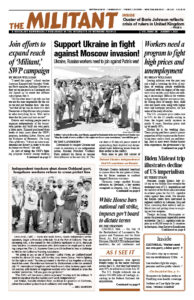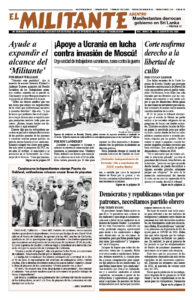LINCOLN, Neb. — On July 14 the Brotherhood of Locomotive Engineers and Trainmen and the Sheet Metal, Air, Rail and Transportation Division (SMART-TD) informed their members, the rail conductors and locomotive engineers who operate freight trains on the major railroads across the U.S., that they had voted by over 99% to authorize a strike July 18.
The U.S. freight railroads run on almost 140,000 miles of trackage, according to the Federal Railroad Administration.
Rail workers’ contracts ran out months ago, for some in June 2021. Under the notorious anti-working-class Railway Labor Act, the unions were barred from striking and forced into mandatory mediation with the bosses. When that ran out without agreement, the bosses and workers were put into a 30-day “cooling-off” period. Within hours of its ending, President Joseph Biden announced July 17 the appointment of a Presidential Emergency Board to take over the talks, with 30 days to hear the two sides, and issue a proposal for a settlement. Then another 30-day “cooling off” period is imposed for both sides to consider the offer.
The conductors’ and engineers’ unions are among 13 rail unions involved in the negotiations, including the Brotherhood of Maintenance of Way and the Transportation Communications Union’s Brotherhood of Railway Carmen.
Collectively, these unions represent some 115,000 railroad workers covered by the various national agreements. They comprise 100% of the workforce that will be impacted by this round of negotiations.
Since the 1880s, each new struggle of rail workers to win better wages and conditions has been met by boss assaults and efforts to “legally” deprive workers from being able to go on strike. This was what led to passage of the 1926 Railway Labor Act, which imposes lengthy delays on unions right to strike and gives the president the power to order federal arbitration.
“I support union rail workers going on strike, this is our only tool against the rail employers to use our collective power against the abuses the working-class faces,” said Lance Anton, an 11-year SMART-TD conductor working in Lincoln.
“Union-organized workers need to see our worth, which only can be done by working together, as the interest of workers and the employers are not the same,” he said. “Our unions need to fight for trains no longer than 50 cars, with a crew of two on each end of the train, because the 2- or 3-mile-long trains today are killing people that live near railroad property.
“A few weeks ago, because there was no protection on a railroad crossing in Missouri, four people died and many passengers were injured after an Amtrak train hit a dump truck and derailed,” Anton said.
What should we do next?
Greg Regan, president of the Transportation Trades Department of the AFL-CIO, which represents 37 labor unions, including the 13 rail worker unions in today’s negotiations, released a statement commending Biden’s arbitration order.
The 13 rail union tops are urging members to reach out to their U.S. senators and House representatives to press for a “labor-friendly” board, and, if necessary, labor-friendly legislation to bring this round of bargaining to a successful conclusion.
As a six-decade member of the conductors’ union, my question is, haven’t those politicians, Democrats and Republicans alike, proved time after time, again and again their opposition to effective labor unions, particularly against rail unions’ right to strike?
I urge workers to read the four-part Teamster series by Farrell Dobbs, who emerged from the ranks of the union to become one of central leaders of the Minneapolis Teamsters strikes in the 1930s and leader of the union’s successful 11-state campaign to organize over-the-road truckers. Dobbs went on to serve as national secretary of the Socialist Workers Party.
The unions must be transformed into mechanisms for independent and militant action by the workers. Government restrictions on the right to strike must be vigorously fought. Internal union democracy must be established so that all questions are debated and decided by the workers themselves. Then, and only then, will organized labor manage to bring its full weight to bear in confrontations with the employers.
Arbitration rigged against workers
Union officials are quick to include a no-strike pledge in contract settlements and refer grievances to arbitration, as opposed to being fought out on the shop floor or the picket line. The workers lose because arbitration boards are rigged against us, invariably being “neutral” on the employers’ side.
“My union’s 99.5% vote to strike shows how railroad crews feel about striking. The company is writing everyone up and harassing us. Even taking the safest course while riding a tank car will get you written up by a boss,” Travis Zuluaga, 32, a Brotherhood of Locomotive Engineers and Trainmen member in the Albany, New York, area, wrote to the Militant. He’s worked 10 years as a conductor and engineer. “It’s about being bullied and feeling threatened daily.
“We’re concerned about the new anti-worker attendance policy, and a lot of confusion about striking. The last strike was 31 years ago,” he said. Very few members of today’s rail unions have ever been on strike.
I remember the 1991 rail strike. We should begin by having regular meetings of our locals for the membership to set strike policy, including where the organized picketing at rail property locations is going to be, to elect picket leaders for each site, and set a tone of discipline — no alcohol, drugs, or weapons on the picket line or in the union strike hall. To start now to reach out for allies, fellow union members in our area, working farmers, students, family and friends.
Set up to inform union members daily of strike progress, to answer lies peddled by the bosses, including the boss’s media, and organize volunteers for food preparation and distribution.
We need to educate, organize and mobilize.

